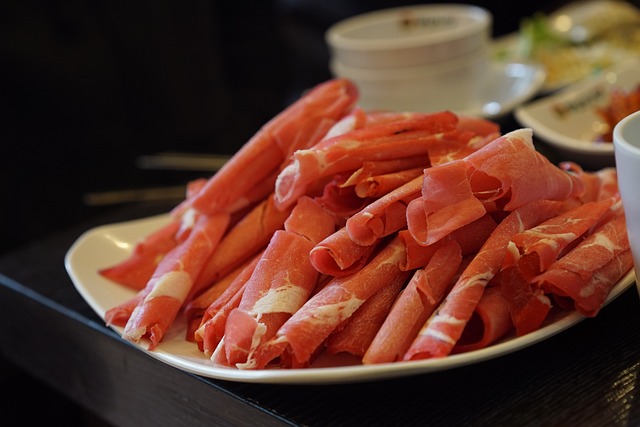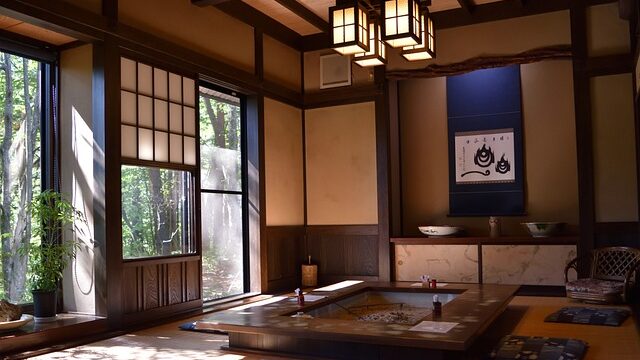Japan, a land of deep-rooted traditions, historical landmarks, and exquisite gastronomy, has always fascinated travelers from around the world. Amid its vast culinary treasures, there’s one dish that stands out for its simplicity, elegance, and delightful flavors – Shabu-Shabu. Dive into the enticing world of this delightful hotpot and learn why it’s a must-try for every traveler to Japan.
1. What is Shabu-Shabu?
At its heart, Shabu-Shabu is a testament to Japan’s deep appreciation for fresh ingredients and the subtle art of cooking. This dish is often likened to a Japanese hotpot, where diners are not just spectators but active participants in the culinary experience.
Shabu-Shabu consists of thinly sliced meat, often beef or pork, which is accompanied by an array of fresh vegetables, tofu, and sometimes even noodles. The meat is so thinly sliced that it appears almost translucent and requires only a quick swish (hence the name “shabu-shabu”) in boiling water or broth to cook.
The broth is another essential element of this dish. It starts off light, with the flavor intensifying as ingredients are added and cooked. By the end of the meal, after all the meat, vegetables, and other accompaniments have been swished and cooked, the broth transforms into a rich, flavorful soup, which is often enjoyed with rice or noodles.
Another distinct feature of Shabu-Shabu is its communal nature. Typically served in a pot placed at the center of the dining table, it encourages sharing and conversation. It’s not just about eating; it’s about the shared experience of cooking, tasting, and enjoying a meal together.
The process of cooking one’s own food, piece by piece, allows diners to savor each ingredient’s distinct flavor, freshness, and texture. This personal, hands-on approach to dining ensures that each morsel is cooked to one’s own preference, making each Shabu-Shabu experience as unique as the individual enjoying it.
In essence, Shabu-Shabu is more than just a meal; it’s a harmonious blend of culinary art, tradition, and communal bonding, making it a truly unique and memorable Japanese dining experience.
2. The Origin of Shabu-Shabu
Shabu-Shabu’s lineage can be traced back to the Chinese hotpot tradition, known as “shuàn yángròu”, which literally means “swishing mutton”. It is believed that the dish was brought to Japan by Chinese travelers or traders, but it wasn’t until it reached the shores of Japan that it evolved and was refined into the Shabu-Shabu we know today.
While the Chinese original predominantly used mutton as the main protein, the Japanese adaptation leaned towards more locally preferred ingredients, with beef taking center stage. Particularly, the rise of Shabu-Shabu in Japan is closely linked to the increased consumption of beef in the country during the Meiji era. As beef consumption became more widespread, different methods of preparation emerged, and Shabu-Shabu found its unique space in Japanese cuisine.
Osaka, a city known for its vibrant food culture and innovative culinary techniques, is often credited with popularizing Shabu-Shabu during the mid-20th century. Local chefs, keen on highlighting the quality of Japanese beef, especially the marbled Wagyu, began serving it in the Shabu-Shabu style. The thin slices of meat showcased not only the beef’s tenderness but also its rich flavor profile, which was perfectly complemented by the boiling broth and fresh vegetables.
Furthermore, the post-war era in Japan saw a rise in communal dining, as it fostered a sense of unity and rebuilding. Shabu-Shabu, with its shared pot and collaborative cooking style, resonated deeply with this ethos, making it an integral part of both family gatherings and formal banquets.
Today, Shabu-Shabu stands as a testament to Japan’s ability to adopt, adapt, and refine culinary practices from other cultures, making them uniquely their own. It’s a dish that tells a story of cultural exchange, regional flavors, and the ever-evolving palate of the Japanese people.
3. Choosing Your Ingredients
Shabu-Shabu is a symphony of flavors and textures, and its beauty truly lies in its adaptability. The dish allows for vast personalization, making every pot a unique creation tailored to individual preferences.
Meats: The star of Shabu-Shabu for many is the meat. Wagyu beef, known for its intricate marbling, buttery texture, and unparalleled flavor, is a popular choice. But there are other premium cuts, such as sirloin or ribeye, which are equally delectable. Beyond beef, thinly sliced pork belly offers a richer, fattier option, while chicken provides a lighter alternative. For seafood enthusiasts, delicate slices of salmon or fresh prawns can also be added to the pot.
Vegetables: The freshness of the vegetables in Shabu-Shabu provides a necessary balance to the richness of the meats. Napa cabbage, with its subtle sweetness, is a staple. Shitake and enoki mushrooms bring an earthy flavor, while the crispness of the Japanese radish (daikon) and the slight bitterness of chrysanthemum leaves offer varied textures and tastes. Some even add sweet potatoes for a hint of sweetness or konnyaku (yam cakes) for their unique jelly-like consistency.
Tofu and Other Add-Ins: Soft tofu, with its ability to absorb the flavors of the broth, is a beloved ingredient. Beyond tofu, there are varieties like “abura-age” (fried tofu pockets) and “atsuage” (thick fried tofu) that add different dimensions to the dish. For those looking to add more substance, Udon noodles or “shirataki” (translucent konjac noodles) can be introduced for a more filling experience.
Broth: The base broth, though seemingly simple, plays a pivotal role. Traditionally, kelp (kombu) is used to create a clear, umami-rich stock. However, regional variations might use chicken or pork bones for a more robust flavor. In recent times, spicy broths infused with chili or miso-based broths have also gained popularity, especially among younger generations.
Accompaniments: Rice or noodles are often served alongside or post the Shabu-Shabu course, using the rich broth that remains after all the ingredients have been enjoyed. This ensures that the flavors cultivated during the meal are fully savored and not a drop goes to waste.
Ultimately, while there are traditional guidelines and popular combinations, Shabu-Shabu is a canvas waiting to be painted with flavors. Whether you’re a purist or an experimenter, the pot welcomes all, promising a delightful culinary journey.
4. Dipping Delights: Sauces and Condiments
In the Shabu-Shabu experience, while the freshly cooked ingredients are a treat in themselves, the sauces and condiments are what elevate the dish to sublime levels. These dips not only add layers of flavor but also allow diners to personalize their bites according to their preferences.
Ponzu Sauce: A favorite among many, Ponzu is a tangy, citrus-based sauce made from yuzu or sudachi citrus fruits combined with soy sauce, vinegar, and sometimes dashi (a clear fish and seaweed-based broth). Its refreshing, light, and slightly tart profile makes it an ideal complement to the rich flavors of the meats, especially beef.
Sesame Sauce (Goma-dare): This creamy, nutty sauce is a blend of ground sesame seeds, soy sauce, sugar, and rice vinegar. The rich texture and deep flavor of the sesame sauce provide a wonderful contrast to the lightness of the vegetables and tofu. Some variations might also incorporate a hint of garlic or chili for an added kick.
Chili Oil (Rayu): For those who prefer a touch of heat, a dash of chili oil can be added to either the Ponzu or Sesame sauce. It provides a spicy undertone without overshadowing the inherent flavors of the primary sauces.
Customizations: One of the joys of Shabu-Shabu is tailoring every bite to your liking. Common additions to the sauces include finely chopped green onions, which offer a fresh bite, and grated daikon, which brings a slightly spicy and crunchy texture. Freshly minced garlic or ground ginger can be added for those seeking a sharper flavor profile.
Condiments on the Side: Beyond the sauces, many Shabu-Shabu places will offer a range of condiments. Pickled vegetables, like kimchi or tsukemono (Japanese pickles), can provide a tangy counterbalance to the richness of the dish. Crushed sesame seeds can be sprinkled over ingredients for an extra layer of nuttiness.
The Art of Mixing: Many diners enjoy mixing and matching to create their own sauce blends. A bit of Ponzu mixed with Sesame sauce, a sprinkle of green onions, a touch of chili oil, and a hint of minced garlic? That’s the beauty of Shabu-Shabu – every dip is a new flavor adventure, and there’s no right or wrong way to enjoy it.
In conclusion, the sauces and condiments in Shabu-Shabu are not just mere accompaniments. They play a pivotal role in the dining experience, allowing each diner to craft a flavor profile that resonates with their palate, making each bite a personalized delight.
5. Where to Experience the Best Shabu-Shabu in Japan?
Japan, with its rich culinary heritage, has many establishments that have perfected the art of Shabu-Shabu over the decades. From high-end restaurants in Tokyo’s upscale neighborhoods to traditional inns in Kyoto, there’s a Shabu-Shabu experience waiting for every traveler.
Tokyo:
- Imafuku: Located in the Minato district, Imafuku is a Michelin-starred restaurant that offers an upscale Shabu-Shabu experience. Here, you can savor premium cuts of Wagyu beef in an elegant setting. The beef is paired with seasonal vegetables and a selection of exquisite broths and sauces.
- Shabusen: Situated in the bustling area of Ginza, Shabusen is popular for both its Shabu-Shabu and Sukiyaki. They source high-quality beef and offer a range of broths, from the traditional to the innovative.
Kyoto:
- Mizuki: Nestled in the heart of Kyoto, Mizuki offers a traditional Japanese dining experience. The restaurant, housed in a beautifully preserved wooden building, serves Shabu-Shabu with a focus on seasonal ingredients and local beef varieties.
- Shabu Shabu Hiro: A favorite among locals, this restaurant is renowned for its delicious broths and premium meat selections. The intimate setting and attentive service make it a must-visit.
Osaka:
- Shabutei: This restaurant is celebrated for its delectable Shabu-Shabu featuring prime cuts of meat. Located in the Umeda district, it’s an ideal place to experience the flavors of Osaka.
- Shabu Zen: A haven for pork lovers, Shabu Zen specializes in pork Shabu-Shabu. Their flavorful broths and a variety of pork cuts have made it a favorite among locals and tourists alike.
Sapporo:
- Shabu Shabu On-yasai: Sapporo, known for its cold winters, is a perfect place to enjoy a hot pot dish. On-yasai offers a comforting Shabu-Shabu experience with a variety of meat options and a selection of locally-sourced vegetables.
While these are just a few recommendations, the beauty of Japan lies in its hidden gems. Sometimes, the most memorable Shabu-Shabu experiences can be found in small, family-run establishments tucked away in a narrow alley or a quiet neighborhood. Wherever you go, be sure to enjoy the ritual, the flavors, and the warmth of Japanese hospitality.
6. Etiquette and Tips for First-Timers
Embarking on a Shabu-Shabu journey can be both exhilarating and slightly daunting for the uninitiated. However, with a few guidelines and tips, even first-timers can navigate this culinary experience like seasoned pros.
Starting Off:
- Heat Control: Before you start, ensure that the broth is boiling. If you’re at a restaurant where you control the heat, keep it at a medium-high setting initially, adjusting as necessary. A gentle rolling boil is ideal for cooking.
The Shabu-Shabu Dance:
- Swishing Technique: When cooking your meat, use your chopsticks to gently swish it back and forth in the broth, ensuring even cooking. The term “Shabu-Shabu” mimics this swishing sound, and it’s where the dish gets its name.
Order of Ingredients:
- Meat First: Start with the meat, as it flavors the broth. Once you’ve enjoyed some slices, you can begin adding vegetables and other ingredients. Denser vegetables like carrots or radishes might take longer to cook, so factor that in as you add items to the pot.
Double Dipping:
- Avoid Double Dipping: If sharing a communal pot, use separate chopsticks for cooking and eating. This ensures that the chopsticks you eat with don’t touch the shared broth, keeping the experience hygienic for everyone.
Sauce Etiquette:
- Sauce Mixing: Feel free to mix and match the sauces provided, but do so in your own plate. This allows everyone to customize their sauces without affecting the shared options.
Ending the Meal:
- Rice or Noodles: Once you’ve enjoyed most of the ingredients, you can add rice or noodles to the richly flavored broth that remains. This ensures no flavors go to waste and provides a filling end to the meal.
General Tips:
- Be Patient: Allow each ingredient enough time to cook and absorb the flavors of the broth. Don’t rush; savor each bite.
- Ask for Guidance: If you’re unsure about anything, don’t hesitate to ask the restaurant staff. They’ll likely be more than happy to guide you through the process.
- Stay Safe: Be mindful of the hot pot, especially if dining with children. Ensure it’s placed securely on the table and be cautious when adding ingredients or adjusting the heat.
Embarking on a Shabu-Shabu dining experience is not just about savoring delicious flavors; it’s about immersing oneself in a culinary ritual steeped in tradition. With these etiquette tips and guidelines, even newcomers will find themselves effortlessly enjoying this quintessential Japanese feast.





